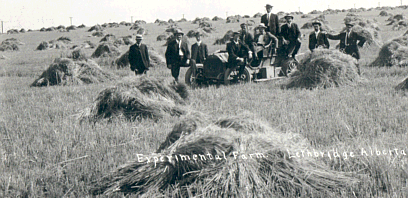
For over ninety years the Lethbridge Research Station has made a significant impact on southern Alberta agriculture. The development of the Research Station can be traced back to 1906, when the Federal government realized that an experimental farm was required to serve the needs of southern Alberta farmers. Although many locations were considered throughout the area, Lethbridge was finally chosen because of what it could offer to such a facility. The presence of both irrigated and dryland farm land was a significant factor, along with the already successfully established sugar beet industry, and the donation of 400 hectares (160 acres) of land from the Alberta Railway and Irrigation Company. Other factors for making Lethbridge the location of the experimental farm included the fact that the Galt company had already established a model farm in the area, and a high opinion of the nearby Mormon settlers in the region. With these factors in mind, Lethbridge was officially selected in 1906 as the 6th experimental farm in Canada.

PhotoFamers at the Experimental Farm
W.H. Fairfield, manager of the Galt model farm, was hired as the first superintendent of the newly established experimental farm. The immediate task of the farm was to research and develop various farming methods and practices that would best suit the southern Alberta region. The earliest experiments focused on horticulture of fruit orchards, shrubs and trees that might be successfully grown in the area. Experiments on irrigated and dryland crops and soil cultures soon followed. By 1911 the results of these experiments began to produce effective results. For example it was found that due to the small amount of rainfall in the southern Alberta region, farmers had to keep one-thrid of their land in summerfallow each year in order to conserve moisture. Results from studies bee keeping along with poultry and livestock feeding were also promising.
The resulting information from these experiments however, were localized and were not benefitting the uninformed farmers in other locations. Thus, in 1915 illustration stations were strategically established in various locations to inform nearby farmers of such things as crop rotations which would greatly enhance productivity. These illustration stations were operated under private farms, but were under the direction of an agricultural officer enlisted by the experimental farm. Illustration stations were established in 15 locations: Bow Island, Carmangay, Empress, Foremost, Grassy Lake, Jenner, Macleod, Magrath, Manyberries, Medicine Hat, Milk River, Pincher Creek, Whitla, High River, and Munson. In addition to the illustration stations, irrigation districts were encouraged and developed. This was primarily due to the results of irrigation experiments, which when compared to dryland farming showed increased yields of wheat by 77 percent, oates by 53 percent, barley by 81percent, and potatoes by 105 percent.
Over the next decades the experimental farm continued to develop and produce useful agricultural information to farmers. In 1920, more land was rented out to conduct experiments on controlling soil drifting, a increasing problem for southern Alberta farmers. In 1925 the first dairy cows were received and experiments on feeding to determine milk production began. Strip farming to break down wind velocity and soil tillage methods were also a main focus, especially in the droughts of the dirty thirties. Further, insect infestations and disease became a focus of concern. Thus, Entomologists and Pathologists were enlisted to combat the devestation of such threats as grasshoppers, cutworms, sawflies, potato psyllids and other pests.
To maintain a high level of development, several specialized laboratories were constructed for the experimental station. These labs included: the livestock insect lab, the field crop insect lab, a science service photographic lab, a wool lab, animal nutrition lab, plant processing and sugar beet lab (also known as a food processing lab), a forage crops lab, and many others. By the 1950's the Lethbridge experimental station and its various science laboratories had become a major agricultural establishment. And, by 1959 the two distinct yet separate branches of the experimental farm and the science services were amalgamated into one research branch. This became known as the Lethbridge Research Station. The amalgamation made the research station the largest of its kind in Canada in terms of staff, area and budget.
As the Twentieth Century approaches, the Lethbridge Research Station will continue to follow its main objective; to serve agriculture. More extensive research and development will continue, and with this so will the foundation of the Lethbridge economy. This will be accomplished by maintaining research in development in over 60 projects a year, helping solve problems and creating new opportunities.
Previous Page | Exhibit Contents | Home | Navigation Information | Glossary | Curriculum Guide | Next Page
Copyright © 1996 Sir Alexander Galt Museum. All rights reserved.